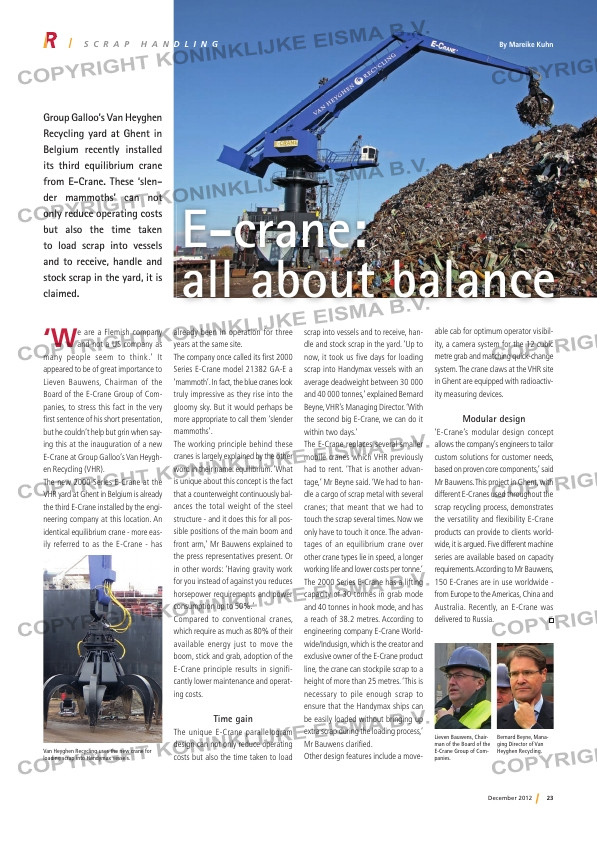Page 23 from: December 2012

23December 2012
Group Galloo’s Van Heyghen
Recycling yard at Ghent in
Belgium recently installed
its third equilibrium crane
from E-Crane. These ‘slen-
der mammoths’ can not
only reduce operating costs
but also the time taken
to load scrap into vessels
and to receive, handle and
stock scrap in the yard, it is
claimed.
‘We are a Flemish company and not a US company as
many people seem to think.’ It
appeared to be of great importance to
Lieven Bauwens, Chairman of the
Board of the E-Crane Group of Com-
panies, to stress this fact in the very
fi rst sentence of his short presentation,
but he couldn’t help but grin when say-
ing this at the inauguration of a new
E-Crane at Group Galloo’s Van Heygh-
en Recycling (VHR).
The new 2000 Series E-Crane at the
VHR yard at Ghent in Belgium is already
the third E-Crane installed by the engi-
neering company at this location. An
identical equilibrium crane – more eas-
ily referred to as the E-Crane – has
already been in operation for three
years at the same site.
The company once called its fi rst 2000
Series E-Crane model 21382 GA-E a
‘mammoth’. In fact, the blue cranes look
truly impressive as they rise into the
gloomy sky. But it would perhaps be
more appropriate to call them ‘slender
mammoths’.
The working principle behind these
cranes is largely explained by the other
word in their name: equilibrium. ‘What
is unique about this concept is the fact
that a counterweight continuously bal-
ances the total weight of the steel
structure – and it does this for all pos-
sible positions of the main boom and
front arm,’ Mr Bauwens explained to
the press representatives present. Or
in other words: ‘Having gravity work
for you instead of against you reduces
horsepower requirements and power
consumption up to 50%.’
Compared to conventional cranes,
which require as much as 80% of their
available energy just to move the
boom, stick and grab, adoption of the
E-Crane principle results in signifi-
cantly lower maintenance and operat-
ing costs.
Time gain
The unique E-Crane parallelogram
design can not only reduce operating
costs but also the time taken to load
scrap into vessels and to receive, han-
dle and stock scrap in the yard. ‘Up to
now, it took us fi ve days for loading
scrap into Handymax vessels with an
average deadweight between 30 000
and 40 000 tonnes,’ explained Bernard
Beyne, VHR’s Managing Director. ‘With
the second big E-Crane, we can do it
within two days.’
The E-Crane replaces several smaller
mobile cranes which VHR previously
had to rent. ‘That is another advan-
tage,’ Mr Beyne said. ‘We had to han-
dle a cargo of scrap metal with several
cranes; that meant that we had to
touch the scrap several times. Now we
only have to touch it once. The advan-
tages of an equilibrium crane over
other crane types lie in speed, a longer
working life and lower costs per tonne.’
The 2000 Series E-Crane has a lifting
capacity of 30 tonnes in grab mode
and 40 tonnes in hook mode, and has
a reach of 38.2 metres. According to
engineering company E-Crane World-
wide/Indusign, which is the creator and
exclusive owner of the E-Crane product
line, the crane can stockpile scrap to a
height of more than 25 metres. ‘This is
necessary to pile enough scrap to
ensure that the Handymax ships can
be easily loaded without bringing up
extra scrap during the loading process,’
Mr Bauwens clarifi ed.
Other design features include a move-
able cab for optimum operator visibil-
ity, a camera system for the 12 cubic
metre grab and matching quick-change
system. The crane claws at the VHR site
in Ghent are equipped with radioactiv-
ity measuring devices.
Modular design
‘E-Crane’s modular design concept
allows the company’s engineers to tailor
custom solutions for customer needs,
based on proven core components,’ said
Mr Bauwens. This project in Ghent, with
different E-Cranes used throughout the
scrap recycling process, demonstrates
the versatility and flexibility E-Crane
products can provide to clients world-
wide, it is argued. Five different machine
series are available based on capacity
requirements. According to Mr Bauwens,
150 E-Cranes are in use worldwide –
from Europe to the Americas, China and
Australia. Recently, an E-Crane was
delivered to Russia.
S C R A P H A N D L I N G By Mareike Kuhn
E-crane:
all about balance
Lieven Bauwens, Chair-
man of the Board of the
E-Crane Group of Com-
panies.
Bernard Beyne, Mana-
ging Director of Van
Heyghen Recycling.Van Heyghen Recycling uses the new crane for
loading scrap into Handymax vessels.
RI_10-E-crane.indd 23 30-11-12 10:01



